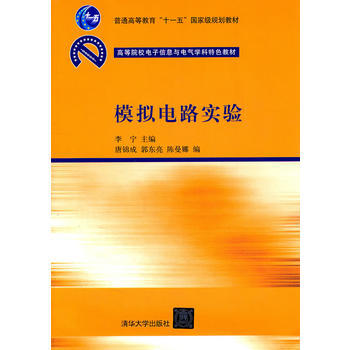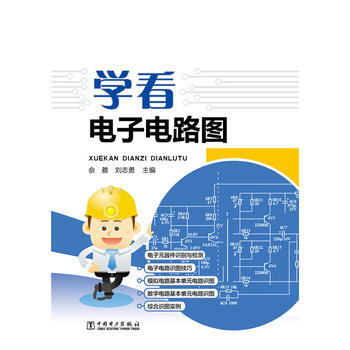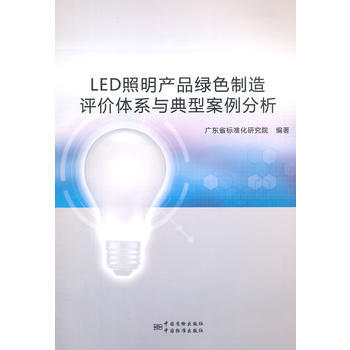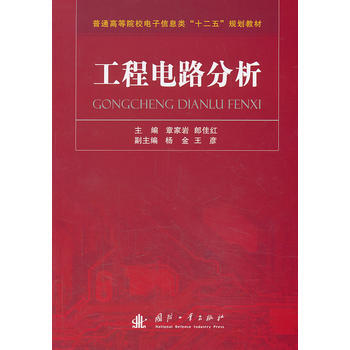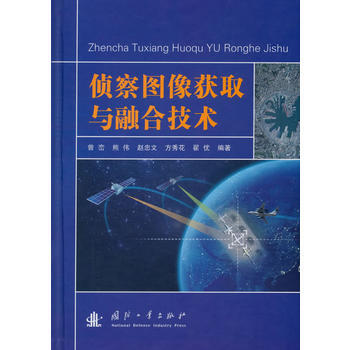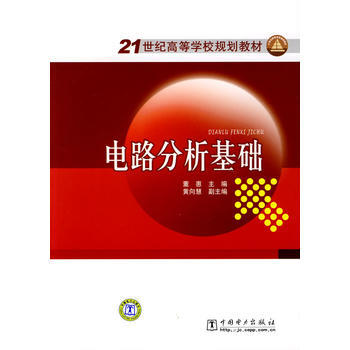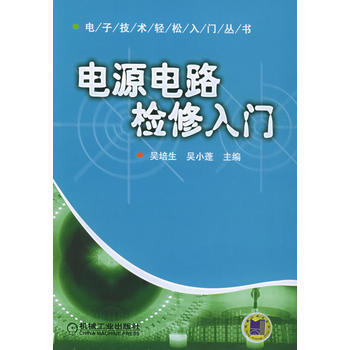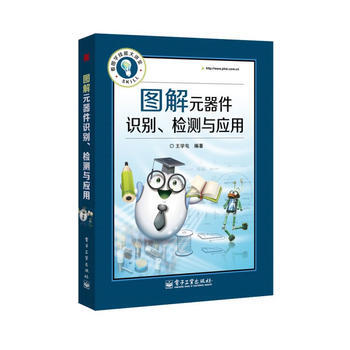

具体描述
基本信息
书名:基本电路理论(第3版 英文版)
定价:52.00元
作者:薛征宇,曲东东,许爱德
出版社:大连海事大学出版社
出版日期:2017-03-01
ISBN:9787563234554
字数:
页码:395
版次:3
装帧:平装
开本:16开
商品重量:0.4kg
编辑推荐
内容提要
《基本电路理论(第3版 英文版)》是为适应电子与电气信息类专业人才培养方案、教学内容体系和教学手段的改革以及高等教育迅速发展的形势而编写的。全书共分19个章节和1个附录。本教材继承了版和第二版的体系和风格,总结了近30年来的电路原理英文版教学探索和经验,在参考了近年来英美国家的同类教材和我国教材体系的基础上,以尽量精炼、地道的专业英语编写出来的。《基本电路理论(第3版 英文版)》可作为电子与电气信息类专业,特别是电气工程及其自动化专业、船舶电子电气工程专业的英文版双语教材和参考书籍。
目录
Chapter 1 Basic Circuit Laws and Simple Resistive Circuits
1.1 Introduction
1.2 Ohm's Law
1.3 Kirchhoff's Law
1.4 Resistance and Source Combination
1.5 Network Reductioby A-Y Transformation
1.6 Source Transformation
1.7 Voltage and Current Division
Chapter 2 General Analysis of Resistive Circuit
2.1 Nodal Analysis
2.2 Mesh Analysis
2.3 Nodal and Mesh Analysis by Inspection
2.4 Linearity and Superposition
2.5 Thevenin' s and Norton' s Equivalent Circuit
2.6 Maximum Power Transfer ithe DC Case
2.7 Input Resistance and Equivalence Resistance
Chapter 3 Op-AMP Resistor Circuit
3.1 The OP-AMP
3.2 Inverting Amplifier
3.3 Noninverting Amplifier
3.4 Summing Amplifier
3.5 Difference Amplifier
3.6 Cascaded OP-AMP Circuit
Chapter 4 Capacitors and Inductors
4.1 The Capacitor
4.2 Series and Parallel Capacitor
4.3 The Inductor
4.4 Series and Parallel Inductors
4.5 Simple OP-AMP Circuits with Capacitors
Chapter 5 First-Order Circuit
5.1 Initial Conditioand Switching Rule
5.2 The Source-Free RC Circuit
5.3 The Source-Free RL Circuit
5.4 The Unit-Step Forcing Function
5.5 Step Response of ARC Circuit and Three-Element Method
5.6 Zero-Input Response and Zero-State Response
Chapter 6 Second-Order Circuits
6.1 The Source-Free Parallel Circuit
6.2 The Source-Free Series RLC Circuit
6.3 The Complete Response of The RLC Circuit
Chapter 7 Sinnsoids and Phasors
7.1 Characteristics of Sinusoids
7.2 Effective Values of Current and Voltage
7.3 The Phasor
7.4 Phasor Relationships For R, L and C
7.5 Impedance
7.6 Admittance
Chapter 8 Sinusoidal Steady State Analysis
8.1 Nodal Analysis and Mesh Analysis
8.2 Superpositioand Thevenin' s Theorem
8.3 Phasor Diagrams
8.4 Instantaneous Power
8.5 Average Power
8.6 Apparent Power and Power Factor
8.7 Complex Power
8.8 Maximum Power Transfer ithe AC Case
Chapter 9 Resonant Circuit
9.1 Parallel Resonance
9.2 Series Resonance
9.3 Other Resonant Forms
Chapter 10 Magically Coupled Circuit
10.1 Mutual Inductance
10.2 The Linear Transformer
10.3 The Ideal Transformer
Chapter 11 Three-Phase Circuits
11.1 Balanced Three-Phase Voltages
11.2 Three-Phase Y-Y Connection
11.3 Balanced Y-A Connection
11.4 The Power Calculatioand Measurement iThree-Phase System
11.5 Brief Introductioto Unbalanced Three-Phase Circuit
Chapter 12 Two-Port Networks
12.1 Admittance Parameters
12.2 Some Equivalent Networks to Two-Port
12.3 Impedance Parameters
12.4 Hybrid Parameters
12.5 TransmissioParameters
12.6 Interconnectioof Two-Port
* 12.7 Gyrator
* 12.8 NIC (Negative-Impedance Converter)
Chapter 13 Technique of Harmonic Analysis for Nonsinusoidal Periodic Current Circuit
13.1 Fourier Series
13.2 Effective Values and Average Power
13.3 The Technique of Harmonic Analysis
Chapter 14 Laplace Transform Techniques
14.1 Definitioof the Laplace Transform
14.2 The Unit-Impulse Function
14.3 Laplace Transforms of Some Simple Time Functions
14.4 Several Basic Theorems for the Laplace Transform
14.5 The Partial-fraction-expansioMethod
14.6 Find the Complete Response
14.7 The Transfer Functio(or Network Function) H(s)
14.8 The Complex-Frequency Plane
Chapter 15 Network Graph Theory
15.1 Notations and Definitions
15.2 Incidence Matrix and KCL
15.3 Loop Matrix and KVL
15.4 Interrelationship BetweeMatrices of a Graph
15.5 Tellegen' s Theorem
Chapter 16 Matrix Equatiofor Network
16.1 Direct Analysis Methods
16.2 Nodal Analysis
16.3 State Variables and Normal-form Equations
16.4 Writing a Set of Normal-form Equations
Chapter 17 Simple Nonlinear Circuits
17.1 Nonlinear Elements
17.2 Simple Nonlinear Resistor Circuits
17.3 Small Signal Analysis
17.4 Combinatioof i-v Characteristics
17.5 Newton-RaphsoAlgorithm
17.6 State-space Analysis: The Phase Plane
17.7 Characteristics of the Phase Portrait
Chapter 18 Switched-Capacitor Circuits
18.1 The MOS Switch
18.2 Analog Operations
Chapter 19 Distributed Circuits
19.1 Uniform TransmissioLines
19.2 Steady State AC Operatioof a Uniform TransmissioLine
19.3 Uniform TransmissioLine Without Losses
19.4 TransmissioLines With Losses——Two Special Cases
19.5 Distributed Circuits of Finite Length
19.6 The Lossless TransmissioLine of Finite Length
Appendix Vocabulary
References
作者介绍
文摘
序言
用户评价
不得不提的是,本书的排版设计也为我的阅读体验增色不少。清晰的字体、合理的行距、以及恰到好处的章节划分,都使得阅读过程更加舒适。图文并茂的设计,让知识的呈现更加生动有趣。每一页的布局都经过精心考量,确保重点内容能够一目了然。这种细节上的追求,体现了作者和出版社的专业性,也进一步提升了本书的整体价值。
评分本书的篇章结构安排得非常合理,过渡自然。从基础的直流电路,到交流电路,再到更复杂的包含瞬态响应和三相电路的内容,每一个主题都建立在前一个主题的基础上,使得整个学习过程连贯而有逻辑。作者在引入新概念时,总是会先回顾相关的旧知识,并解释新概念与旧概念之间的联系,这对于巩固和深化理解非常有帮助。我发现,当我遇到某个稍微难懂的概念时,回过头来查阅前面的章节,总能找到清晰的铺垫和解释,这极大地减少了我的学习障碍。
评分这本书的确是一部引人入胜的学术巨著,初次捧读,便被其严谨的逻辑和深刻的洞察力深深吸引。我尤其欣赏作者在阐述基本概念时所展现出的耐心和细致,仿佛是在为初学者铺设一条平坦的道路,引导他们一步步深入理解电学世界的奥秘。从最基础的欧姆定律、基尔霍夫定律开始,每一个公式的推导都清晰明了,配以丰富的图示,让抽象的理论变得触手可及。那些看似枯燥的符号和公式,在作者的笔下活了起来,展现出它们在实际电路中扮演的重要角色。举例来说,关于电阻串联和并联的部分,作者不仅仅是给出了计算公式,更是通过类比生活中的水流或者交通流量,让读者能够直观地理解电流和电压在不同连接方式下的行为差异。这种“润物细无声”的教学方式,让我这个之前对电路理论有些畏惧的读者,也逐渐建立了信心。
评分我非常喜欢本书在概念引入时所采用的“由浅入深”的方法。作者不会一开始就抛出复杂的数学公式,而是先用生动形象的语言和简单的模型来解释核心思想,然后再逐渐引入更严谨的数学描述。这种方式极大地降低了学习门槛,让初学者能够快速建立起对电路基本概念的初步认识。例如,在介绍电场和磁场时,作者会从日常生活中的静电现象和磁铁入手,然后逐步引申到电场和磁场在电路中的作用。这种循序渐进的学习路径,让我感觉自己是在一步步搭建知识的台阶,而不是被动地接受信息。
评分我非常赞赏本书在概念讲解深度上的平衡。它既不像某些入门书籍那样流于表面,而是深入到各个基本定律的物理意义和推导过程,又不像某些高级教材那样过于晦涩,使得初学者望而却步。作者仿佛拥有某种魔法,能够将复杂的电路行为分解成一系列简单易懂的步骤。例如,在讨论电容和电感时,作者没有简单地罗列它们的特性,而是通过分析电荷存储和磁场生成的过程,深刻地揭示了它们在电路动态响应中的作用。对于瞬态分析部分,书中提供的多种解题方法,如拉普拉斯变换和微分方程法,都进行了详细的讲解,并配以大量的实例,让我得以反复练习,直到完全掌握。这些实例的设计非常贴合实际应用,涵盖了滤波电路、振荡电路等常见场景,极大地增强了理论知识的实用价值。
评分本书的深度和广度都给我留下了深刻的印象。它不仅涵盖了电路理论最核心的知识点,还涉及到一些与之相关的进阶话题,为读者提供了一个非常全面的视角。我尤其赞赏作者在章节末尾设置的“思考题”和“挑战题”。这些题目不仅能够帮助我们巩固所学的知识,还能激发我们对电路原理的进一步探索。它们的设计往往能够触及到理论的深层含义,或者要求我们将所学知识应用于一些实际场景,这是一种非常有效的学习方式。
评分本书最令我印象深刻的一点在于其对问题解决策略的强调。作者深知,学习电路理论不仅仅是为了理解概念,更重要的是能够运用这些概念去分析和解决实际问题。因此,书中在讲解完基本理论后,会立刻引入一系列精心设计的例题,这些例题的难度梯度设置得非常合理,从简单到复杂,循序渐进。更重要的是,作者在解析例题时,不仅仅给出了最终答案,更侧重于分析解题思路和步骤,甚至会探讨多种可能的解题途径,并分析各自的优劣。这种“授人以鱼不如授人以渔”的教学理念,让我学会了如何分析一个陌生电路,如何找到关键节点,如何运用适当的理论工具,最终找到问题的解决方案。这种学习过程,让我感觉自己不仅仅是在被动接收知识,而是在主动地构建自己的电路分析能力。
评分从物理直觉的角度来说,这本书为我打开了一扇新的大门。在阅读过程中,我常常能感受到作者试图将抽象的数学模型与真实的物理现象联系起来的努力。他会通过形象的比喻和深入的分析,帮助读者建立对电路行为的“感觉”。例如,在解释交流电路中的相位差时,作者并非简单地给出正弦函数的相移公式,而是通过水的波浪运动或者音乐的频率变化来类比,让读者能够直观地理解不同信号在时间和空间上的“不同步”。这种对物理直觉的培养,对于理解更复杂的电路现象至关重要。我发现,一旦建立了良好的物理直觉,很多看似棘手的电路问题,都能迎刃而解。
评分作为一本英文原版教材,本书的语言风格我非常欣赏。它既保持了学术的严谨性,又充满了清晰度和流畅性。作者在遣词造句上力求精准,避免了不必要的术语堆砌,使得即使是非英语母语的读者,也能够相对轻松地理解。此外,书中对图表的使用也堪称典范。每一幅电路图都清晰标注,每一个波形图都准确描绘,这些视觉辅助工具与文字描述相得益彰,共同构建了一个完整且易于理解的学习环境。我尤其喜欢书中那些精心绘制的示意图,它们能够将复杂的内部工作原理以直观的方式展现出来,极大地缩短了我的理解过程。
评分本书的实用性是我非常看重的一点。书中大量的工程实例和应用场景的分析,让我深刻体会到电路理论在现实世界中的重要作用。我不再觉得这些枯燥的公式和定律只是纸上谈兵,而是它们是支撑现代科技发展的基石。例如,书中对于滤波器设计和功率放大器分析的详细讲解,让我能够更好地理解许多电子设备的工作原理。这种将理论与实践相结合的教学方法,极大地激发了我学习的积极性。
相关图书
本站所有内容均为互联网搜索引擎提供的公开搜索信息,本站不存储任何数据与内容,任何内容与数据均与本站无关,如有需要请联系相关搜索引擎包括但不限于百度,google,bing,sogou 等
© 2025 book.coffeedeals.club All Rights Reserved. 静流书站 版权所有







